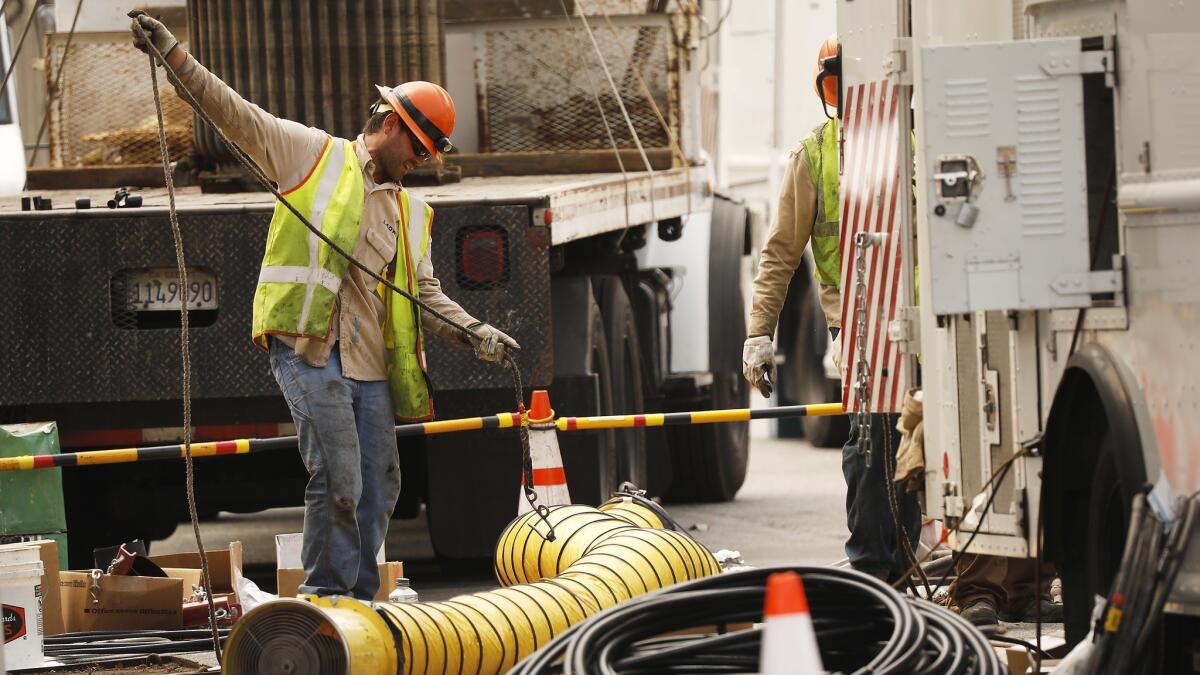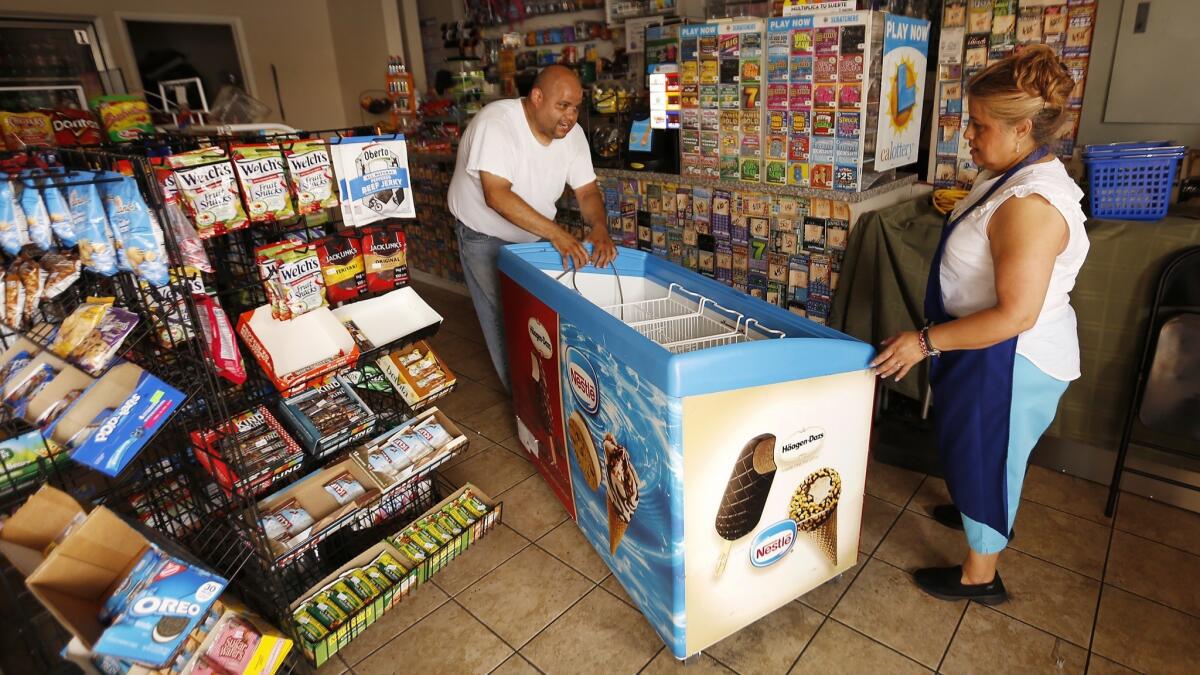Hundreds of customers are still without power as hot and angry Angelenos fume at the DWP

- Share via
Before the scorching heat descended on Los Angeles last week, the Department of Water and Power assured residents it had “adequate resources” to meet the electrical demands of their air conditioners and refrigerators as temperatures rose.
It did, in fact, have enough power to go around, utility officials said Monday, after tens of thousands of people had suffered outages.
But officials said that in many neighborhoods, its aging infrastructure could not handle the surging demand for electricity as Angelenos ran their air conditioning day and night.

Tens of thousands of people lost electricity as Los Angeles baked in sizzling heat this weekend, leaving many residents fuming as they went days without power. Some complained that the utility gave them scant information as they debated whether to bunk with friends or family, board their dogs or spring for a hotel room to avoid the overbearing heat.
“It’s not so much that power has been out for 36 hours, which is horrible, it’s the lack of communication,” Miracle Mile resident Evan Wolf said Sunday.
Wolf and his husband used a tub of water to cool down their three dogs and kept fans, a refrigerator and wireless internet going with a generator as temperatures hit 94 degrees in his home Saturday. His power eventually came back Monday — 55 hours after it first went out, Wolf said.
More than 80,000 people were affected at some time by the power outages, which had left 46,000 customers without electricity at their worst point, said DWP spokesman Joseph Ramallo. Peak electricity use reached 6,256 megawatts Friday — a record for a July day — and exceeded 5,700 megawatts Saturday, making it the second-highest weekend day in Los Angeles history, according to the utility.
The power outages “were due to sudden, extreme heat coupled with record electricity demand at the neighborhood level in parts of the city that do not typically get as hot as it did on Friday and Saturday,” Ramallo said.
Utility officials said that skyrocketing demand in the heart of the city, spurred by the searing heat, had triggered hundreds of different outages, some linked to underground equipment that was harder to reach quickly and repair. Most of the neighborhoods affected were south of Mulholland Drive, where electrical infrastructure is decades older than in the San Fernando Valley, DWP officials said.
“When we have an event like this,” said Marty Adams, DWP’s chief operating officer, “you find all the weak links. All driven by the high power demands.”
The blistering heat and spotty information infuriated many residents as the outages dragged on over the weekend. After the power outages began Friday, the utility initially told customers that power probably would be restored within 12 to 24 hours, then changed its estimates to 24 to 48 hours in a statement Saturday night, cautioning that some complicated repairs could take longer than 48 hours.
In Jefferson Park, Maura Gierl said her husband got a robocall from the utility informing them that electricity would be back by 7 p.m. Saturday. It was not, she said. Gierl, who had already spent one night in a hotel with her husband, her 8-month-old baby and their dog, resigned herself to another night away from home, worrying about the food and the frozen breast milk spoiling in her fridge.
“We weren’t getting any sort of information,” Gierl said, complaining that her neighborhood did not even show up on official maps of the outage released by the DWP.
Although the DWP released regular statements about the number of customers without power in L.A. neighborhoods and gave general estimates for how long people might need to prepare for outages, many residents were aggravated with the lack of firm answers on when their power would be restored. In some areas, power came back, only to go out again.
Utility officials said they had been sharing as much information as they had with residents, but that it was difficult to give precise estimates on when power would be restored at each site. “The reality of what happens in the field is, until they start tearing it apart, they may not know the extent of the problem,” Adams said.
Mayor Eric Garcetti echoed that assessment, calling it “unpredictable work.”
As the electricity started to go out in thousands of homes Friday and Saturday, Garcetti was out of town on a personal trip.
Some residents were frustrated that there had not been more information from city officials including Garcetti, whose official Twitter feed relayed information from the DWP, but provided few new details about the outage.
Garcetti defended the response Monday, saying that his office had retweeted the utility because it had the “best information there is.”
By Monday morning, more than 7,000 customers still lacked electricity. The hardest-hit neighborhood was Koreatown, where the utility said that 2,200 customers remained without power that morning.
Utility officials said that as of Monday afternoon, the number of people without electricity had fallen to roughly 1,900, including 113 people in Koreatown, and that they expected most people to have their power back by midnight.
After the power went out Friday at his shop on 6th Street in Koreatown, Carlos Zuniga ended up throwing out roughly $1,000 worth of milk, popsicles and ice cream. As the power outage dragged into Sunday, he bought a generator to keep running one of his three refrigerators and the computer that sells lottery tickets. He said utility workers had told him Monday that power would be restored by the end of the day.
“Hopefully that will be true,” Zuniga said midday Monday. “They haven’t been right so far.”
Twelve years ago, thousands of Angelenos lost power in the city as hundreds of transformers malfunctioned or stopped working. At the time, the DWP ultimately acknowledged that the utility had badly underestimated how much electricity would be in demand as temperatures soared. Those power outages spurred new demands to improve its electrical infrastructure, giving rise to a “power reliability” program focused on upgrading old equipment.
Los Angeles leaders gave their approval two years ago to a series of rate hikes to help repair and replace aging infrastructure. Last budget year, the DWP replaced more than 3,000 electrical poles and more than 900 distribution transformers, according to its website. Fred Pickel, the city ratepayer advocate, said the utility had significantly boosted its spending on such upgrades, but “we’re still in a decades-long replacement process.”
Despite that work, the DWP has repeatedly fallen short of annual goals for reducing the frequency and duration of power outages, according to the data on its website. Utility officials said the agency nonetheless compares well with other electrical utilities.
Environmentalists warned that problems stemming from extreme heat are not going to go away. “What we’re experiencing now — we’re going to see a lot more of it in the future,” said Jonathan Parfrey, executive director of the nonprofit Climate Resolve and a former DWP commissioner.
Parfrey argued that as climate change drives up temperatures, L.A. needs to find ways to reduce demand for electricity, including installing cooler pavement and planting trees to reduce urban temperatures. “Just telling people to stop cooling themselves down — I don’t think that’s a good strategy,” Parfrey said. “People are going to fire up the AC when it gets above 100 degrees.”
William Funderburk, an attorney who recently left the board that oversees the utility, called the recent outages “a harbinger of things to come.”
DWP has been “meeting and exceeding energy efficiency mandates and goals,” Funderburk said. “But it’s clear that those mandates and goals may not be enough.”
UPDATES:
5:55 p.m.: This article was updated with new information throughout.
This article was originally published at 11:30 a.m.
More to Read
Sign up for Essential California
The most important California stories and recommendations in your inbox every morning.
You may occasionally receive promotional content from the Los Angeles Times.












